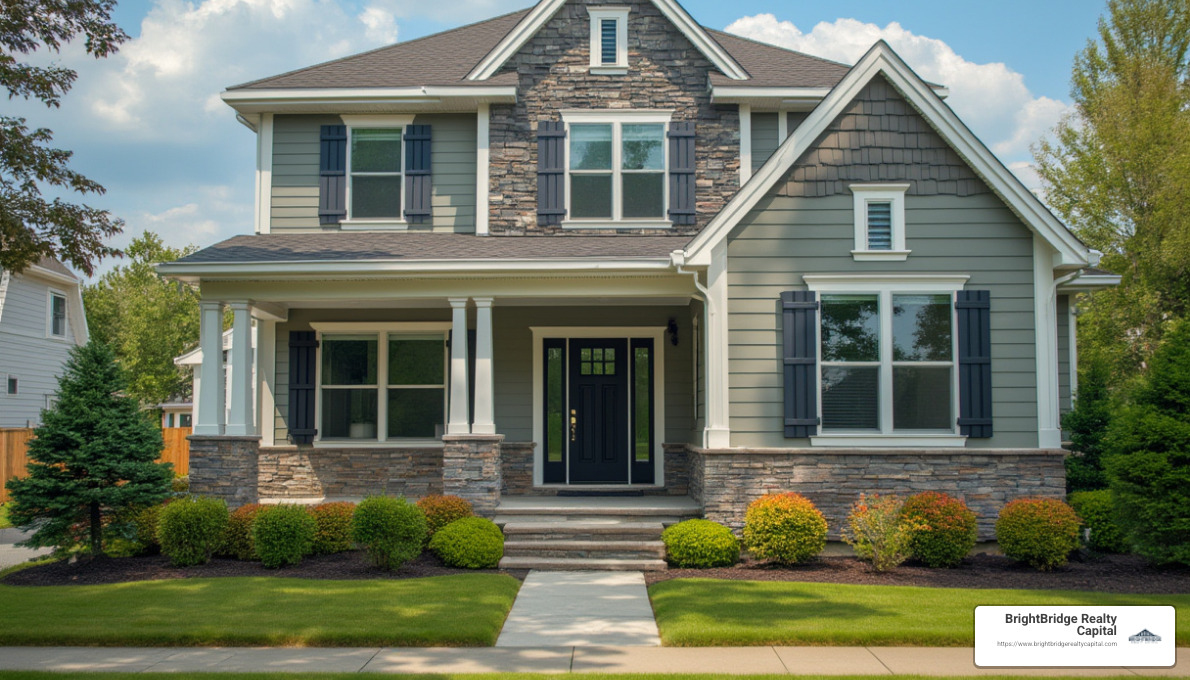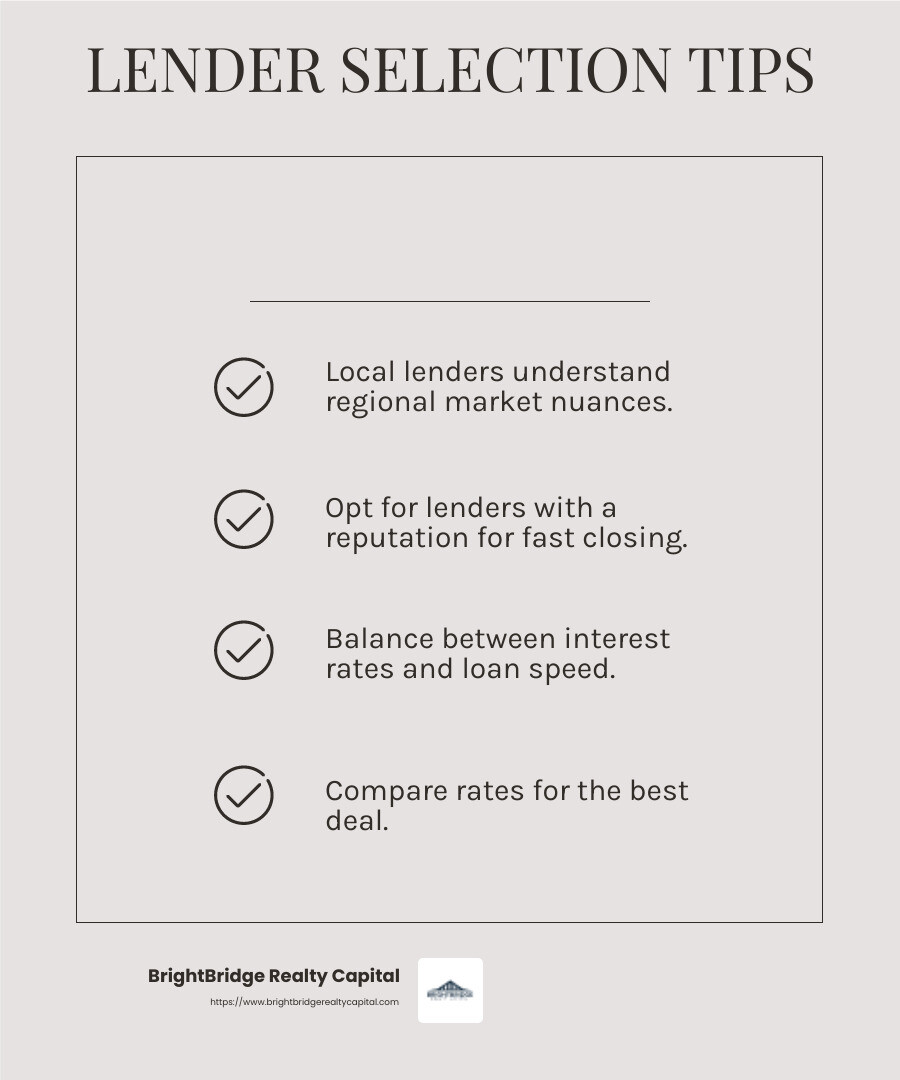How to Secure Fix and Flip Loans for Real Estate Success

Fix and flip real estate loans are a crucial piece of the puzzle for investors looking to turn dated properties into profitable ventures. This short-term financing helps real estate entrepreneurs purchase, renovate, and resell these houses quickly and efficiently. For those skilled in the trade, understanding the nuances of these loans can spell the difference between a successful venture and a costly mistake.
- What They Are: Short-term loans designed for purchasing, renovating, and selling properties.
- Key Benefit: Quick, flexible financing to seize investment opportunities.
- Best for: Investors seeking efficiency in flipping properties for profit.
Real estate strategy and timely investment decisions often hinge on securing the right kind of loan—one that aligns with your project timeline and financial goals. But with numerous options available, finding the perfect fit can be daunting. The choice of a loan, typically asset-based, holds significant bearing on your return on investment (ROI) and the overall success of your endeavor.
Understanding the basic structure and purpose of these loans is vital for any real estate investor. Exploring options such as hard money and FHA 203(k) loans empowers you to harness short-term financing powerfully.

Simple fix and flip real estate loans glossary:
- rehab loans for real estate investors
- property development loans
- private investor loans for real estate
Understanding Fix and Flip Real Estate Loans
Fix and flip real estate loans are essential for investors aiming to transform outdated properties into profitable assets. These loans are typically short-term, designed to help you buy, renovate, and sell properties quickly. They are asset-based, meaning they rely on the value of the property itself rather than the borrower's creditworthiness.
Key Features of Fix and Flip Loans
Interest-Only Loans: Many fix and flip loans are structured as interest-only loans. This means you pay only the interest during the loan term, which can help manage cash flow during the renovation process. Once you sell the property, you pay off the principal.
Flexible Terms: These loans often offer flexible terms, allowing you to tailor the repayment schedule to your project timeline. This flexibility can be crucial when unexpected delays occur during renovations.
High Leverage: Fix and flip loans provide high leverage, covering a significant portion of the purchase and rehab costs. This enables investors to undertake more projects with less of their own capital.
Types of Fix and Flip Loans
Hard Money Loans: Hard money loans are a popular choice for fix and flip investors. These loans are provided by private lenders and are known for their quick approval process. They often come with higher interest rates but offer the speed and flexibility needed to capitalize on investment opportunities.
FHA 203(k) Loans: These loans are backed by the Federal Housing Administration (FHA) and are designed for purchasing and renovating properties. They have lower interest rates compared to hard money loans but come with stricter requirements and limitations on the types of renovations allowed.
VA Rehab Loans: For veterans and active-duty military members, VA rehab loans offer a unique option. These loans combine the benefits of a VA loan with the ability to finance renovations, making them an attractive choice for eligible borrowers looking to flip properties.

Each type of loan has its advantages and limitations. The right choice depends on your specific needs, the property's condition, and your timeline for flipping the house. By understanding these options, you can better steer the complexities of real estate investment and maximize your potential returns.
Steps to Secure a Fix and Flip Loan
Securing a fix and flip real estate loan involves several important steps. Understanding what lenders look for and how to prepare your application can make the process smoother and increase your chances of approval.
Preparing Your Application
Lender Requirements
Different lenders have unique criteria. Most focus on the property's value and your experience. Be prepared to show your ability to manage a renovation project and successfully flip a property.
Credit Score
While these loans are asset-based, a decent credit score can still help. Many lenders prefer a minimum score of 620. A higher score might get you better terms.
Property Appraisal
An appraisal helps determine the property's current value and its potential worth after renovations. This is crucial for lenders to assess the risk and decide on the loan amount.
Example: If the after-repair value (ARV) is projected at $200,000, a lender offering 70% ARV might lend up to $140,000.
Project Details
Provide a clear outline of your project. Include timelines, renovation plans, and cost estimates. This shows lenders you have a solid plan and understand the scope of work.
Rehab Scope
Detail the specific renovations you plan to undertake. A comprehensive rehab plan helps lenders evaluate the project’s feasibility and potential profitability.
After-Repair Value (ARV)
This is a key factor. It estimates the property's value post-renovation. Lenders use ARV to calculate how much they’ll lend. A strong ARV can secure a higher loan amount.
Choosing the Right Lender
Local Lenders
Local lenders often have a better understanding of the real estate market in your area. They might offer more competitive rates and terms custom to local conditions.
Fast Closing
Time is money in real estate. Look for lenders known for quick approvals and fast closings. This agility can be crucial in a competitive market.
Competitive Rates
Compare different lenders to find the best rates. While hard money loans might have higher interest rates, they offer speed and flexibility that can be worth the cost.

By following these steps and being well-prepared, you can streamline the process of securing a fix and flip loan. This preparation not only boosts your chances of approval but also helps you get the best possible terms for your investment.
Benefits of Fix and Flip Loans
Fix and flip real estate loans offer several advantages for investors eager to dive into property flipping. These loans are designed to provide the financial support needed to purchase, renovate, and sell properties quickly.
Quick Funding
One major benefit of fix and flip loans is the speed at which funds can be accessed. Traditional loans can take weeks or even months to process, but fix and flip loans are often approved and funded much faster. This is crucial in competitive markets where great deals can disappear overnight. With quick funding, investors can seize opportunities without delay.
Flexible Financing
These loans offer flexible terms custom to the unique needs of each project. Whether you need a short-term loan or specific financing for extensive renovations, fix and flip loans can be customized to fit your requirements. This flexibility is especially beneficial for investors juggling multiple projects or dealing with unexpected changes in renovation plans.
High Returns
The potential for high returns is a driving force behind the popularity of fix and flip projects. By purchasing properties at a lower cost, investing in renovations, and selling at a higher price, investors can achieve significant profits in a relatively short period. This makes fix and flip loans an attractive option for those aiming to maximize their investment returns.
Potential Risks and Challenges
While the benefits are enticing, there are also risks and challenges associated with fix and flip loans.
High Interest Rates
One of the downsides is the typically higher interest rates compared to traditional loans. This is due to the short-term nature and increased risk associated with these types of investments. It's important for investors to calculate the total cost of borrowing and ensure that the potential profits outweigh these expenses.
Market Timing
Success in property flipping heavily depends on market conditions. An unexpected downturn in the real estate market can impact the ability to sell the renovated property at a profit. Investors must be vigilant and informed about market trends to mitigate this risk.
Renovation Delays
Renovations can be unpredictable. Delays due to unforeseen issues like structural problems or contractor availability can eat into profits and extend the timeline for selling the property. Having a contingency plan and budgeting for potential delays is crucial for managing these challenges.
In summary, while fix and flip loans offer quick funding, flexible financing, and the potential for high returns, they also come with challenges such as high interest rates, market risks, and renovation delays. Being aware of these factors can help investors make informed decisions and increase their chances of success in the fix and flip market.
Frequently Asked Questions about Fix and Flip Real Estate Loans
What is the typical duration of a fix and flip loan?
Fix and flip loans are designed for short-term use, usually ranging from 12 to 18 months. This short duration aligns with the typical timeline for purchasing, renovating, and selling a property. Some lenders offer extensions if needed, but it's crucial to plan your project timeline carefully to avoid extra costs.
How much of the rehab cost can be financed?
The amount of the rehab cost that can be financed varies by lender. Generally, fix and flip loans can cover up to 100% of the renovation budget. For example, BrightBridge Realty Capital offers loans that finance 100% of the rehab expenses, allowing investors to focus on changing properties without worrying about out-of-pocket costs for renovations.
Are there any prepayment penalties?
Prepayment penalties can vary depending on the lender. Many fix and flip loans do not have prepayment penalties, which means you can pay off the loan early without incurring additional fees. This is advantageous for investors who complete their projects ahead of schedule and want to minimize interest costs. Always check with your lender to understand the specific terms of your loan agreement.
Conclusion
In real estate, securing the right financing can make all the difference. At BrightBridge Realty Capital, we understand that every investor's journey is unique. That's why we offer customized solutions custom to fit your specific needs. Whether you're flipping your first property or you're a seasoned investor, our approach is designed to help you succeed.
Our seamless process is one of our key strengths. We pride ourselves on fast closings, often within a week, which means you can seize opportunities without delay. This quick turnaround is crucial in the competitive world of real estate, where timing can significantly impact your returns.
With our direct lending approach, we cut out the middleman, allowing us to offer competitive rates and a streamlined experience. Our team of experts is dedicated to guiding you through every step, ensuring a hassle-free process from your initial application to the final payoff.
Choosing BrightBridge Realty Capital means partnering with a lender that prioritizes your success. Our nationwide reach ensures you have access to funding wherever your investment journey takes you. Ready to transform your real estate investments with fix and flip real estate loans? Explore our services and find how we can help you achieve your real estate goals.


